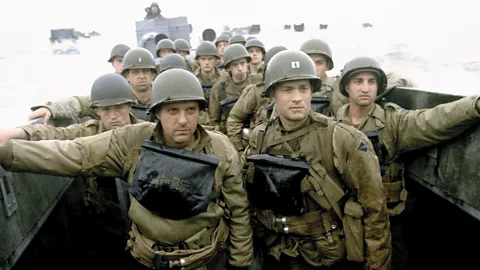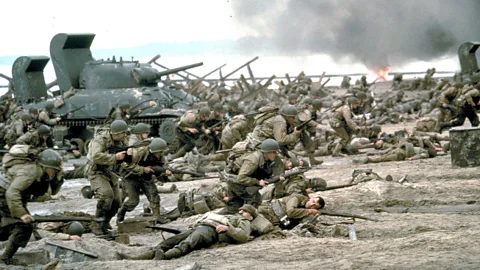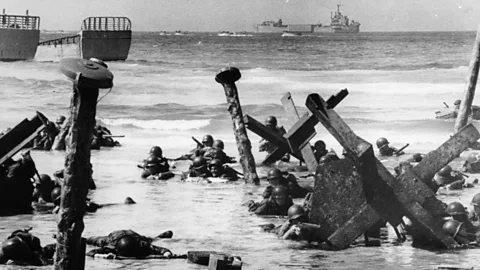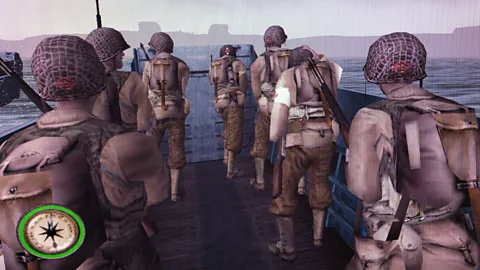How Saving Private Ryan's D-Day sequence changed the way we see war
 Alamy
AlamyToday marks 80 years since the momentous World War Two Allied operation – and back in 1998, Steven Spielberg's brutally immersive depiction of what happened left an indelible mark on cinema history, and the world.
Among the 156,000 allied troops who landed in Normandy on 6 June 1944 were cameramen of the British/Canadian Army Film and Photographic Unit and the American Field Photographic Unit. Across the invasion beaches, they captured a remarkable record that quickly found its way into newsreels on both sides of the Atlantic, beginning a cinematic obsession with D-Day which has persisted for 80 years. From Henry Koster's romantic melodrama D-Day the Sixth of June (1956) through to Julius Avery's zombie-horror actioner Overlord (2018), filmmakers have remained understandably fascinated with the spectacle and human drama of the Normandy landings. But no film has shaped the popular imagination of D-Day as thoroughly as Steven Spielberg's 1998 masterpiece, Saving Private Ryan.
Spielberg brought audiences closer than ever to the horrifying sights and sounds of combat, reinventing the war movie in the process. The opening battle scene, depicting the US landings on Omaha Beach, remains an astonishing and utterly harrowing vision of war as hell, unlike anything previously found in mainstream US cinema. "In these 23 minutes of screentime, Spielberg created a moment of film history that deserves its place alongside Eisenstein's Odessa steps, Ford's stagecoach chase, and Kurosawa's rain-swept Samurai battle in the pantheon of great movie action sequences," writes James Chapman, professor of film studies at the University of Leicester, in his book War and Film.
 Alamy
AlamyA watershed moment
Filmed on Ireland's east coast with some 2,500 reservists from the Irish Defence Forces as extras, the sequence's commitment to authenticity is unflinching. The landing craft ramp falls, and young soldiers are eviscerated by bullets and mortars before they can even step on to the beach. Shell-shocked boys search for their own missing limbs while others scream for their mothers as their guts spill on to the blood-drenched sand. Janusz Kamiński's unsteady, bleached cinematography intentionally recalls original newsreel footage and the photography of Robert Capa, while the score composer John Williams offers no musical accompaniment to the cacophony of gunfire and death. "Hopefully, if we've played our cards right, the audience will think that we were there," says Spielberg in behind-the-scenes documentary Making Saving Private Ryan.
Its significance as a watershed moment in cinema history was immediately recognised. Janet Maslin's review in The New York Times proclaimed Saving Private Ryan to be "the finest war movie of our time", while Roger Ebert said the action was "as graphic as any war footage I've ever seen". The film has since entrenched itself as the benchmark for the modern war movie and the definitive cinematic statement on World War Two. Its shadow looms over every combat film of the last quarter-century, from Ridley Scott's Black Hawk Down (2001) to Edward Berger's All Quiet on the Western Front (2022). Spielberg himself worked on the 1999 first-person-shooter videogame Medal of Honor and 2001 TV miniseries Band of Brothers, both of which took cues from Saving Private Ryan's tone and visual style, and spawned their own imitators.
More like this:
"The movie is so powerful and so skilfully made that it has stayed with us perpetually as a kind of visual and emotional base point for what we imagine Omaha Beach and Normandy must have been like. It is accurate enough that it does enhance popular historical understanding. Some of the incidents that the film portrays are taken directly from survivor accounts," John C McManus, professor of US military history at Missouri S&T and author of The Dead and Those About to Die: The Big Red One at Omaha Beach, tells the BBC. "In spite of plenty of Omaha Beach inaccuracies – soldiers too close together, obstacles pointed in the wrong direction, sustained machine gun fire with no melted barrels, flamethrowers taking pillbox bunkers – I do view it as a masterpiece of sorts.
"Even so, the movie portrays the absolute worst moments of the fighting, not necessarily the typical experience of those who were there. If you were unlucky enough to land in the first wave at Dog Green sector, then you probably did experience horrors akin to what we see in the movie. If you happened to land in the dead spots between the beach exits, especially later in the day, the situation was much less severe."
 Alamy
AlamyIndeed, the relentlessly subjective point-of-view offered by Spielberg intentionally prevents his audience from grasping the bigger picture of D-Day – to brutally immersive effect. While earlier Normandy epics like Darryl F Zanuck's The Longest Day (1962) gave a broad view of the battle, including sweeping aerial shots and lengthy sequences from the German perspective, Spielberg makes no such effort to contextualise the action. Everything on Omaha is experienced from the limited perspective of Tom Hanks's Captain Miller. The Wehrmacht enemy raining fire upon him are vague outlines, crouched behind snarling machine guns or scuttling between distant fortifications.
Even less screentime is dedicated to America's allies in the Normandy campaign, their only mention being a brief, disparaging refence to the "overrated" British General Montgomery. "Saving Private Ryan manages to give the impression that D-Day was an entirely American affair," James Chapman tells the BBC. "British historians were at pains to point out that more British and Commonwealth troops were in the field on 6 June than Americans."
Beyond the beaches
After the radically violent opening battle, Robert Rodat's script moves into more conventional territory, reminiscent of classic "men-on-a-mission" action-adventure films like The Guns of Navarone (1961) or Where Eagles Dare (1968). Days after the invasion, Captain Miller is ordered to assemble a squad and move inland in search of Private Ryan (Matt Damon), a paratrooper whose three brothers were recently killed in action. Although loosely based on the true story of the Niland brothers, it's an improbable premise that uses Normandy as a backdrop for a series of fictionalised action sequences, teasing out the moral contradictions of war in the process.
While Miller and his squad initially grumble about the absurdity of their mission, risking their eight lives to save one man, they eventually come to realise, in the words of Tom Sizemore's Sergeant Horvath, "someday we might look back on this and decide that Saving Private Ryan was the one decent thing we were able to pull out of this whole god-awful, shitty mess". Ryan is more than an individual – he represents a means by which these brutalised young men may hold on to their humanity amid the most inhumane slaughter. It functions as a metaphor for the essential moral righteousness of America's broader liberating mission in World War Two, despite the appalling ruthlessness and sacrifice it required.
 Getty Images
Getty ImagesIt has been argued that despite its technical innovation, Saving Private Ryan is a deceptively conservative film, with a vein of US exceptionalism betrayed by the fluttering stars-and-stripes at its bookends. "Ideologically, it seems to be part of a project in American cinema to reclaim World War Two around 50 years after the event as 'the good war', following the Vietnam cycle of the 1970s and 80s," says Chapman. "See also: Pearl Harbor (2001), Windtalkers (2002), U-571 (2000), and most obviously Band of Brothers on TV."
Amid the moral confusion and disillusionment of post-Vietnam, post-Cold War America, World War Two and the defeat of fascism was framed as a reassuring bedrock for the moral character of the modern United States. Saving Private Ryan is Spielberg's expression of thanks to the generation that won this victory of good over evil. When a dying Captain Miller tells Private Ryan, "earn this", his words seem to represent the debt of gratitude owed by every American to those sacrificed "upon the alter of freedom".
This is not to say the film is uncomplicatedly triumphalist. Despite its patriotic trappings, the script takes an ambiguous attitude towards heroism, and doesn't shy away from the psychological toll of war. Captain Miller's hands shake uncontrollably, while he and the veteran Army Rangers under his command are prone to fits of crying; obvious signs of combat fatigue, or what would now be called post-traumatic stress. It's a far cry from John Wayne's macho stoicism in The Longest Day.
But while Miller and most of his squad manage to control their fears in the heat of battle, Jeremy Davies' bookish Corporal Upham fails this test. Although familiar with the rousing war poetry of Tennyson and Emerson, he cannot summon such fortitude within himself. Unaccustomed to combat, he is crippled by fear during the climactic battle, and unable to act in defence of his friends. It's an agonising moment, and unusual for a Hollywood war film to depict cowardice in its heroes. Although those who have never experienced war may scorn Upham and aspire to Captain Miller's courage and coolness under fire, the unattractive truth is that to be an effective soldier requires brutal instincts that many simply do not possess.
 Alamy
AlamyBut Spielberg is too sentimental a filmmaker to dwell for long on such human frailty. At the film's denouement, as a tearful, elderly Ryan salutes the grave of his fallen comrade while Williams's score reaches a gently manipulative swell, a cynic might be tempted to roll their eyes. In spite of this old-fashioned sentimentality, or perhaps because of it, it's hard not to surrender to the awesome power of this film.
Those looking for a historical account of what happened on D-Day might be better served by The Longest Day or any number of documentaries. But Saving Private Ryan communicates the experience of war – the physical sensations, the responsibilities, and the mental scars – with unprecedented honesty. There's bravery, camaraderie and sacrifice, yes, but also fear, horror and shame. On the 80th anniversary of D-Day, as these experiences slip painfully from living memory, Spielberg's hymn to the fallen is more resonant than ever.
--
If you liked this story, sign up for The Essential List newsletter – a handpicked selection of features, videos and can't-miss news, delivered to your inbox twice a week.
